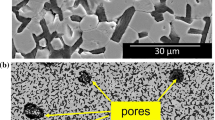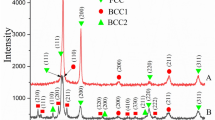Abstract
The oxidation kinetics of commercial purity Ti-A55 exposed to laboratory air in the 593–760°C temperature range were continuously monitored by thermogravimetric analysis. The oxide thickness was measured by microscopy and the substrate contamination was estimated from microhardness measurements. The microhardness depth profiles were converted to oxygen composition profiles using calibration data. The oxygen diffusion coefficient in alpha-Ti appears to be approximately concentration independent in the 1–10 at. % oxygen range. The combination of an “effective diffusion coefficient” and an “effective solubility” at the oxide-metal interface usefully describes the diffusion process over the entire composition range. A model for the total parabolic oxidation kinetics, accounting for the two individual components, oxide growth and solid solution formation, has been proposed. Diffusion coefficient for oxygen in TiO2 has been estimated as a function of temperature and is found to be about 50 times the value in alpha-Ti. The metallographically prepared cross-sections of the oxidized specimens revealed a “moving boundary” in the substrate, parallel to the oxide-metal interface. This boundary was associated with a specific oxygen level of 5.0±0.5 at.%. It occurred at a distance from the oxide-metal interface which was correlatable with temperature and time of exposure. The diffusion coefficient corresponding to the composition of this moving boundary is in excellent agreement with the effective diffusion coefficient for the substrate contamination.
Similar content being viewed by others
Abbreviations
- A s :
-
Area underC s vs.X profile, at. % oxygen times cm
- C s :
-
Concentration of oxygen in the alpha-Ti solid solution (see Fig. 1), at. %.
- C z :
-
Concentration of oxygen in the oxide (see Fig. 1), at.%
- D o :
-
Frequency factor, cm2 sec−1
- D s :
-
Diffusion coefficient of oxygen in the alpha-Ti solid solution, cm2 sec−1
- D z :
-
Diffusion coefficient of oxygen in the oxide, cm2 sec−1
- erfc :
-
Error function complement
- KHN :
-
Knoop hardness number (subscripts 5 g and 15 g represent indenter loads)
- Q :
-
Activation energy for oxygen diffusion in oxide or in solid solution, cal mol−1
- R :
-
Gas constant,=1.987 cal mole−1 deg K−1
- r :
-
Oxide growth constant defined by z =rt 1/2, cm sec−1/2
- T :
-
Temperature, K
- t :
-
Time, sec
- W if :
-
Total weight gain per unit area from initial and final weights, g cm−2
- W z :
-
Weight gain per unit area due to oxide growth, g cm−2
- W zs :
-
Total weight gain per unit area due to oxide and solid solution, =w z +w s , g cm−2
- X :
-
Distance from oxide-metal interface, cm
- X mbb :
-
Distance of the “moving boundary” from the oxide-metal interface, cm
- z :
-
Oxide thickness, cm
- if :
-
Obtained from initial and final weights of specimen
- l :
-
Solubility limit
- mb :
-
Of “moving boundary” in solid-solution
- zs :
-
For the oxide plus solid-solution
- o :
-
Corresponding to base level
- 5g:
-
With 5 gram load
- 15g:
-
With 15 gram load
References
P. H. Morton and W. M. Baldwin,Trans. Amer. Soc. Met. 44, 1004 (1952).
A. E. Jenkins,J. Inst. Met. 82, 213–221 (1953–1954).
J. E. Reynolds, H. R. Ogden, and R. I. Jaffee,Trans. ASM 49, 280–299 (1957).
S. Andersson, B. Collen, U. Kuylenstierna, and A. Magneli,Acta. Chem. Scand. 11, 1641–1652 (1957).
P. Kofstad, K. Hauffe, and H. Kjollesdall,Acta. Chem. Scand. 12(2), 239–266 (1958).
J. Stringer,Acta. Met. 8, 758–766 (1960).
T. Hurlen,J. Inst. Met. 89m, 128–136 (1960–1961).
C. E. Shamblen and T. K. Redden,The Science, Technology and Application of Titanium, R. I. Jaffee and N. E. Promisel, eds. (Pergamon Press, New York, 1968), pp. 199–208.
C. J. Rosa,Metall. Trans.,1, 2517–2522 (1970).
L. E. Dunbar, A. F. Mills, G. H. Burghart, and R. M. Clever, 2nd AIAA/ASME Thermophysics Conf., 1978, Paper No. 78–867.
J. E. L. Gomes and A. M. Huntz,Oxid. Met. 14(6), 471–498 (1980).
M. Hansen,Constitution of Binary Alloys, 2nd edition (McGraw-Hill Book Company, New York, 1958), p. 1069.
C. Wagner,Diffusion in Solids, Liquids, Gases, W. Jost, ed. (Academic Press, New York, 1952), p. 71.
J. Debuigne and P. Lehr,Rev. Met. 60, 911 (1963).
G. R. Wallwork, W. W. Smeltzer, and C. J. Rosa,Acta Met. 12, 409 (1964).
K. E. Wiedemann and J. Unnam, An X-Ray Diffraction Study of Titanium Oxidation, TMS-AIME Paper No. F84-14, 1984.
R. P. Elliott,Constitution of Binary Alloys, First Supplement (McGraw-Hill Book Company, New York, 1965), p. 697.
R. N. Blumenthal and D. H. Whitmore,J. Electrochem. Soc. 110, 92 (1963).
J. S. Andersen and A. S. Khan,J. Less-Common Met. 22, 219 (1970).
B. C. H. Steele and S. Zador, Ph.D. Thesis (S. Zador) University of London, 1969.
P. Kofstad,Nonstoichiometry, Diffusion, and Electrical Conductivity in Binary Metal Oxides (Wiley Interscience, New York, 1972), pp. 141.
J. Crank,The Mathematics of Diffusion (Oxford University Press, London, 1964).
Robert C. Weast, ed.,Hand Book of Chemistry and Physics, 52nd edition (The Chemical Rubber Company, Cleveland, OH, 1971–1972), p. B-150.
P. Kofstad, P. B. Anderson, and O. J. Krudtaa,J. Less-Common Met. 3, 89–97 (1961).
K. E. Wiedemann, MS Thesis, Virginia Polytechnic Institute and State University, 1983.
D. David, E. A. Garcia, X. Lucas, and G. Beranger,C.R. Acad. Sc., Paris t.287, 125–128 (1978).
E. Bisogni, G. Mah, and C. Wert,J. Less-Common Met. 7, 197 (1964).
C. J. Rosa,Metall. Trans.,1, 2517–2522 (1970).
Author information
Authors and Affiliations
Additional information
Formerly with Vigyan Research Associates, Inc., 28 Research Drive, Hampton, VA 23666.
Rights and permissions
About this article
Cite this article
Unnam, J., Shenoy, R.N. & Clark, R.K. Oxidation of commercial purity titanium. Oxid Met 26, 231–252 (1986). https://doi.org/10.1007/BF00659186
Received:
Revised:
Issue Date:
DOI: https://doi.org/10.1007/BF00659186




